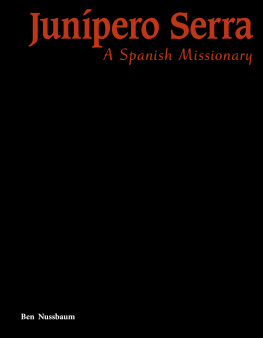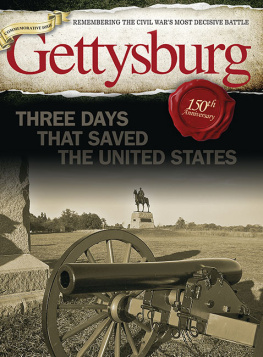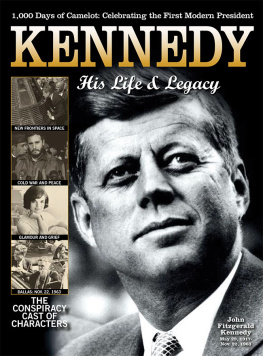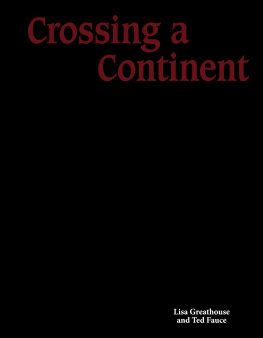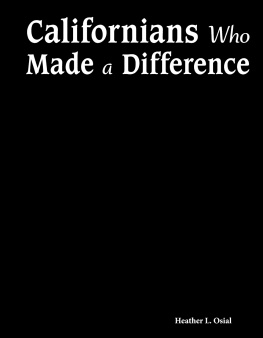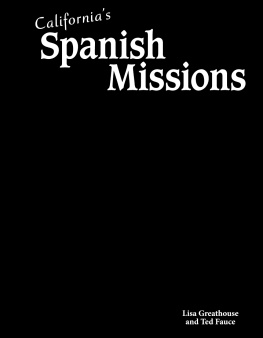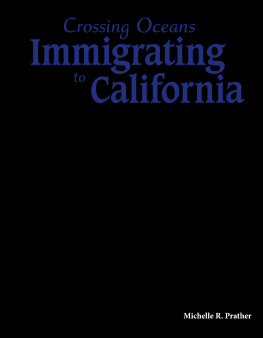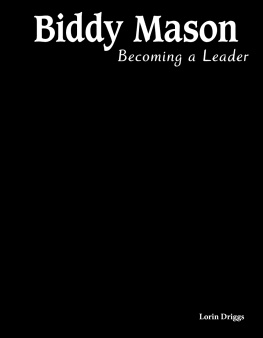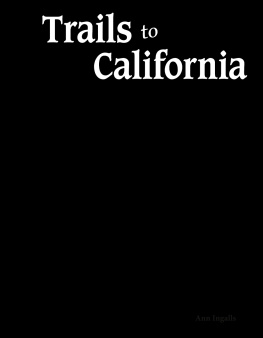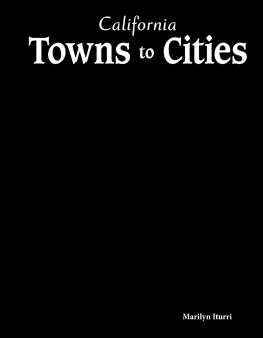Ben Nussbaum - Junípero Serra: A Spanish Missionary
Here you can read online Ben Nussbaum - Junípero Serra: A Spanish Missionary full text of the book (entire story) in english for free. Download pdf and epub, get meaning, cover and reviews about this ebook. year: 2018, publisher: Triangle Interactive, LLC, genre: History. Description of the work, (preface) as well as reviews are available. Best literature library LitArk.com created for fans of good reading and offers a wide selection of genres:
Romance novel
Science fiction
Adventure
Detective
Science
History
Home and family
Prose
Art
Politics
Computer
Non-fiction
Religion
Business
Children
Humor
Choose a favorite category and find really read worthwhile books. Enjoy immersion in the world of imagination, feel the emotions of the characters or learn something new for yourself, make an fascinating discovery.
- Book:Junípero Serra: A Spanish Missionary
- Author:
- Publisher:Triangle Interactive, LLC
- Genre:
- Year:2018
- Rating:5 / 5
- Favourites:Add to favourites
- Your mark:
- 100
- 1
- 2
- 3
- 4
- 5
Junípero Serra: A Spanish Missionary: summary, description and annotation
We offer to read an annotation, description, summary or preface (depends on what the author of the book "Junípero Serra: A Spanish Missionary" wrote himself). If you haven't found the necessary information about the book — write in the comments, we will try to find it.
Junípero Serra: A Spanish Missionary — read online for free the complete book (whole text) full work
Below is the text of the book, divided by pages. System saving the place of the last page read, allows you to conveniently read the book "Junípero Serra: A Spanish Missionary" online for free, without having to search again every time where you left off. Put a bookmark, and you can go to the page where you finished reading at any time.
Font size:
Interval:
Bookmark:
0covercover.xhtmlJunpero Serra A Spanish Missionary Ben Nussbaumcover1page0001page0001.xhtmlRead and Respond 1. What were some obstacles Junpero Serra overcame to reach California? 2. How did Serra improve the missions during his time in Sierra Gorda? 3. Describe how the Spanish missions helped or hurt the American Indians. 4. Were Serra's goals reached? What facts would you use to support this argument? 5. Explain the term "under the bell. " Why is the concept important? 6. Create at least five interview questions to ask a California Indian about what life was like on a mission. Include his or her responses.22page0002page0002.xhtmlJunpero Serra A Spanish Missionary33page0003page0003.xhtmlMission Carmel44page0004page0004.xhtmlTable of Contents Attack on the Mission 4 An Island Boy 6 New Spain 12 California at Last! 20 Final Goodbyes 26 Plan It! 28 Glossary 30 Index 31 Your Turn! 3255page0005page0005.xhtmlAttack on the Mission Today, San Diego is one of the biggest cities in the United States. In 1769, it was just a fort and a mission. A handful of Spanish priests and soldiers lived there in a few simple buildings. Many of them were sick. All of them were hungry. One day in August, about 20 American Indians attacked the mission. They ripped blankets away from the sick men and took anything else they could find. Two priests took shelter in a hut. One of them was hit in the hand by an arrow. The other was Junpero (hoo-NEE-peh-roh) Serra. He clutched a crucifix. The priests' young servant burst into the hut, an arrow in his throat. Serra prayed over the boy as he died. Serra was in California to bring Christianity to the American Indians. He did not give up. Six years later, San Diego was attacked again. Serra didn't give up then, either. Early Struggle The early days of the mission at San Diego were very tough. Many people died trying to supply the mission. One ship became lost, and almost all the crew died of scurvy. These American Indians are helping build a mission.66page0006page0006.xhtmlJunpero Serra statue at Mission Carmel77page0007page0007.xhtmlAn Island Boy Junpero Serra was born to a poor family. He lived in the town of Petra, in the middle of Majorca (may-YOR-kuh), an island in the Mediterranean Sea. His father and mother were farmers. They worked a few small fields around Petra. They did not own the fields. They had to pay to be allowed to farm the land. Majorca is beautiful. It has mountains and many beaches. However, during Serra's life, most of the people on Majorca struggled. The island was very dry. When there wasn't enough rain, people could not grow food. Hunger was common. Diseases swept through the island. New Spain, the Spanish empire in the New World, was far away. Majorca was small compared to New Spain, but many missionaries came from the island. One reason for this might be that people who grew up on the island were used to hard work and overcoming hardships. A House Mule The Serra family's mule slept in the house. This was normal! On Majorca, people relied on their animals. Majorca, Spain88page0008page0008.xhtml Childhood Church Serra was baptized at the San Pedro church in Petra. The church was built when Serra was a child. It still stands.99page0009page0009.xhtmlWhen Serra was a teenager, hunger and illness killed about a quarter of the people in Petra. Many of his aunts, uncles, and cousins died. Serra was often sick. He was very short, possibly because he did not have enough to eat. His parents had to make a hard choice. Because Serra was pious and very good at school, he could become a priest. His parents would not have to take care of him. The church would provide everything he needed. When Serra was 15 years old, his parents took him to Palma, the biggest city on Majorca. There, he started on the path to becoming a Franciscan priest. Serra entered the San Francisco monastery in Palma. First, he spent a year as a novice. He prayed and fasted. He then served as an altar boy. Saint Francis Church in Majorca, Spain A Step Up Serra was a poor boy from a small village. The stunning monastery in Palma must have seemed amazing to him. Parts of the monastery were hundreds of years old when Serra was a student.1010page0010page0010.xhtml Followers of Francis St. Francis of Assisi founded the Franciscans. He was known for his love of nature. He called birds, wolves, and other creatures his brothers and sisters. St. Francis also had a passion for imitating the life of Jesus. He even tried to suffer like Jesus. painting of St. Francis of Assisi1111page0011page0011.xhtmlSerra spent the next few years in deep study. When he was 24 years old, he became a priest. He quickly grew a strong reputation. He was chosen to teach other Franciscans. When he wasn't teaching, he gave powerful sermons. After hearing one, another priest said it was "worthy of being printed in letters of gold. " Churches around the island invited Serra to give sermons. He even preached in his hometown of Petra. His parents must have been proud! Despite his success, Serra's heart was far away. On Majorca, everyone was a Christian. Serra dreamed about introducing the faith to the people of distant lands. Serra prayed. He debated. Finally, he made a choice. His future was in New Spain. You won't find New Spain on a map today. In Serra's day, New Spain was a large part of North America, including all of Mexico. The pope wrote a letter in 1523. It let priests convert the Mexican Indians. Favorite Books Serra loved reading about famous Franciscans. He mainly liked to read about priests who traveled as missionaries. He looked up to these men.1212page0012page0012.xhtml A New Name Many Franciscans chose new names during their time of study. Serra changed his name. His name used to be Miguel. He changed it to Junpero to honor a companion of St. Francis. This map shows which countries owned land in North America in 1750.1313page0013page0013.xhtmlNew Spain After a dangerous voyage, Serra landed in Veracruz on December 4, 1749. Nineteen other priests were with him. One of them was Francisco Palou (pah-LOH), Serra's close friend. Palou later wrote a book about Serra. Next, the priests had to trek for 250 miles (402 kilometers) to Mexico City. Most of the priests rode horses. But Serra and one other priest walked. The two priests on foot struggled. According to Palou's book, a mysterious person appeared late one night to give them shelter. The next day, another man unexpectedly showed up on the road to give them fruits. The day after, the same man appeared on the road. He gave them bread. For Serra, this man was a sure sign that God was protecting him. During the walk, Serra's leg became infected by insect bites. For the rest of his life, his leg was often in pain. Mosquito Food! Antonio Margil (MAHR-heel) was a missionary in New Spain before Serra. He was one of Serra's heroes. Margil was known to allow bugs to bite him. He did not want to deprive them of food! Mexico City was one of Serra's first stops in New Spain.1414page0014page0014.xhtml Holy Visions Serra was inspired by Mara de Jess de Agreda (ah-GRAY-duh). The nun wrote that angels helped her travel to New Mexico and Texas to preach to the American Indians. She claimed that she was able to travel while her body stayed in Spain. Her stories were very vivid. She influenced many priests to go to New Spain.1515page0015page0015.xhtmlSierra Gorda After a few months of rest and prayer in Mexico City, Serra and Palou were sent to Sierra Gorda. This was an area in the mountains north of Mexico City. The Spanish had dominated the Western Hemisphere for more than two hundred years. This included Sierra Gorda. The five missions there were in bad shape. Some buildings were falling down. Others were too small. Attendance at Mass was low. Serra stayed in Sierra Gorda for eight years. Under his leadership, Franciscans gave new life to the missions. They built new churches. Serra helped design the new buildings and supervised their construction. The priest did not avoid hard work. He carried stones. And he lifted heavy beams. In Sierra Gorda, Serra fought a rich family that wanted to take land away from the American Indians. He also fought soldiers who he thought abused the natives for no reason. 1747 map of the Spanish missions in Mexico1616page0016page0016.xhtml Important Art In Serra's time, books were rare. Statues and paintings were the best way to show scenes from the Bible and Christian history. The churches Serra built were filled with art that priests used to teach American Indians. Mission Sierra Gorda1717page0017page0017.xhtml A Mission Home Missions were far more than just churches. They had farmland and animals. Soldiers protected them. In some ways, they were like small villages. Oxen and plows were used to farm on mission lands. Hard Work! Ringing the bells was complex. Different patterns and tones meant different things. Bell ringers were specially trained for the task. Mission Loreto in Baja California1818page0018page0018.xhtml"Under the Bell" Today, most people think of religion as something personal. It is about what is inside people's hearts. Serra did not see it this way. For Serra, being a devout Catholic required a regular schedule with frequent prayer. It meant Mass every Sunday and feast days, which are days to celebrate saints. To bring God to the natives of New Spain, Serra made them live "under the bell" the mission bell. The bell told everyone when to pray. It told them when to wake up, eat, and go to sleep. Serra convinced American Indians to live in the mission by giving them gifts and food. Once they agreed to live there, they had little freedom. They were forced to farm. If they fled, soldiers tracked them down. When the natives broke the rules, they were punished and even whipped by soldiers. Serra condoned all of these actions. That is why he is considered controversial (kahn-truh-VUHR-shuhl).1919page0019page0019.xhtmlPreaching with Passion Picture Serra giving a sermon in a church lit by candles. He opens his robe, revealing his bare chest. He holds a large, lit candle in one hand. Then, he puts out the flame on his chest to show the pain of sin. After eight years in Sierra Gorda, Serra spent a decade teaching in Mexico City and leading revivals around Mexico. In Majorca, Serra was known for preaching with logic and learning. In New Spain, he added drama. Serra sometimes held a rock in one hand and bashed it against his chest. Sometimes, he whipped his back with a chain. Serra had a unique attitude toward pain. He thought it brought him closer to Jesus. It was also penance for sin. Serra's attitude was common in his day. Best Friends Palou first met Serra on Majorca, where he was one of Serra's students. Palou was part of Serra's life for more than 40 years! In New Spain, they often worked together.2020page0020page0020.xhtml Intentional Itch Serra sometimes wore a scratchy undershirt known as a hair shirt. It was made out of itchy goat hair. He used the shirt as a form of penance. Palou wrote a book about Serra (shown left). It included drawings, such as this one that shows Serra preaching to a group of Mexican Indians.2121page0021page0021.xhtmlSpanish explorers discover San Francisco Bay. California at Last! By the time Serra was in his 50s, he had lived in New Spain for almost 20 years. In that time, he was able to do so much for the church. He had restored the missions at Sierra Gorda. Then, he joined the College of San Fernando. He held many jobs at the college, even leading the choir. But Serra wanted to do more. He wanted to keep his focus on baptizing the "pagan" American Indians.2222page0022page0022.xhtmlSoon, he was chosen to lead the missions in Baja California. (Baja means "lower. ") But many of the American Indians in those missions had already been baptized. This did not bring him closer to his lifelong goal of converting new people to the faith. In 1768, Spain wanted to expand their land. The leaders decided to use religion to make this possible. They chose to build missions in Alta California. (Alta means "upper. ") This was the chance for Serra to reach his goal. Serra said he would lead the effort. He wrote that he "praised God" and "kissed the ground. " Ulterior Motive Spain had full control of Mexico for many years. They did not have the same control in California. Then, the Russians began exploring the area. Spain created the missions as a way to keep Russia from claiming the land. Dangerous Work! In 1758, Serra thought he would be stationed in San Sab, Texas, with his friend Palou. They were going to replace two priests who had been killed by Comanche (kuh-MAN-chee) Indians. Spanish officials changed their minds and decided to abandon the mission there.2323page0023page0023.xhtmlHis first year in California, Serra founded the mission in San Diego. The next year, he founded a mission in Monterey. The year after that, he founded two more. By 1782, there were nine missions. They made a path that reached all the way to San Francisco. Serra wrote that he was "where no Christian foot had trod before. " He baptized thousands of American Indians. With each baptism, he welcomed a person into the Christian faith. This gave him great joy. Two priests perform a baptism.2424page0024page0024.xhtmlIn 1778, he confirmed three American Indians who had killed a priest at Mission San Diego in 1775. For Serra, the murder was the act of "poor, ignorant" people. He forgave them. He wanted to save their souls. He did not care about punishing them. On the Move Serra often walked from mission to mission. Some historians guess that he walked more than 5, 000 miles (over 8, 000 kilometers). That's a long distance! It's equal to walking across the United States twice. Serra wrote letters to the church about his work.2525page0025page0025.xhtmlAs he had in Sierra Gorda, Serra sought to bring American Indians "under the bell. " It was not enough to tell them about God. He wanted them to live near priests and to have settled lives. Serra was a strict teacher. To apply the rules of the mission, he felt that priests should be able to punish the natives. Serra devoted his life to his faith and the missions. He was tough and determined. But he brought more than faith. At the missions, Serra made sure that natives were educated. They were also taught to farm. But Serra and the missions also had negative effects. He changed and destroyed entire cultures. American Indians lost their languages and customs. Serra also helped usher in diseases that killed many of the American Indians. This is why Father Serra is a controversial person. Serra's room at Mission Carmel2626page0026page0026.xhtml A Historic Saint In 2015, Pope Francis came to the United States to canonize Serra. The church wanted to honor Serra for spreading his religion and converting people so far from his home. But the Pope's act stirred debate. Taking a Stand In Washington, DC, Pope Francis honored Serra. In California, many American Indians were angry that Serra was named a saint. Protests were staged at some of the missions in the state.2727page0027page0027.xhtmlFinal Goodbyes In 1784, Serra was 70 years old. He had spent 15 years in California. His last years had been challenging. Many of the priests who had come to the state with Serra were ill or had died. The strict rules that Serra used to control the missions had taken a toll. The missions were devastated by disease and revolts. His faith and determination pushed him as far as he could go. He had plans for more missions, but he would not be there to see the last of the missions built. That summer, Serra became very sick. His friend, Francisco Palou, rode to be by Serra's side. After several days of prayer, Serra peacefully passed away. He died clutching a crucifix. The bells of the mission tolled. A week later, his body was buried. Father Fermn Lasun (fehr-MEEN lah-SOOEHN) took over after Serra's death. He oversaw the building of nine more missions. The missions continued to operate for many more years. Serra is buried beneath the church floor at Mission Carmel. A Slow Message Alta California was very remote. It took three months for the news of Serra's death to reach Mexico City. It took another four months for a letter to reach Majorca.2828page0028page0028.xhtml The Mission Legacy After Serra died, more missions were built in California. A total of 21 missions were built. Most of the missions are still active churches today! In 1924, a memorial for Serra was built at Mission Carmel. It is made of bronze and marble.2929page0029page0029.xhtmlPlan It! Choose one of the missions founded by Serra. You're in charge of planning a field trip for your class to this mission. To make sure your classmates fully explore the mission, create a scavenger hunt. Research your mission and find at least 10 landmarks, artifacts, or important parts of the mission. Use words, symbols, maps, or pictures to help your classmates find the items. A checklist might help them keep track of what they have found. Compare your scavenger hunt list with a classmate!3030page0030page0030.xhtml3131page0031page0031.xhtmlGlossary baptized sprinkled water on as part of a religious ceremony canonize officially declare a saint by the Roman Catholic Church condoned treated something bad as acceptable confirmed administered a sacrament in the Catholic Church to celebrate and strengthen a person's faith controversial disagreed upon for a long time crucifix a depiction of Jesus on the cross devout deeply religious fasted went without food Franciscan member of a religious order started by St. Francis monastery a place for monks or priests to live and study novice someone new at something; someone in the first year of the process of becoming a priest pagan a person outside traditional religion penance something a person does to show he or she is sorry pious very religious revivals times when people return to focus on their religious beliefs scurvy a disease caused by a lack of vitamin C sermons the lessons priests give during Mass usher to come before as if to lead in3232page0032page0032.xhtmlIndex Alta California, Baja California, baptism, Carmel, confirmed, de Agreda, Mara de Jess, Francis of Assisi, Saint, Lasun, Fermn, Majorca, Margil, Antonio, Mexico, Mexico City, New Spain, Palma, Palou, Francisco, Petra, Pope Francis, San Diego, San Sab, sermon, Sierra Gorda, "under the bell, " Mission San Juan Capistrano3333page0033page0033.xhtmlYour Turn! A New Statue Statues of Junpero Serra are in many places. There's even one in the U.S. Capitol building in Washington, DC. Imagine that your community is putting up a statue of Serra. Your job is to write a speech about Serra. You are also in charge of writing the words that will go on the plaque below the statue. There are reasons to honor Serra. There are also reasons to discredit Serra. He did things throughout his life to support both viewpoints. When creating the plaque for the statue, think about both points of view. The writing on the plaque should be no more than five sentences. How will you communicate your viewpoint clearly? Will you choose to honor him, discredit him, or find a way to do both? Your speech should be a paragraph in length. In your speech describe how you feel about Serra's impact on California. Use evidence from Serra's actions during his lifetime to support your ideas. Be fair and honest.3434page0034page0034.xhtmlRead and Respond 1. What were some obstacles Junpero Serra overcame to reach California? 2. How did Serra improve the missions during his time in Sierra Gorda? 3. Describe how the Spanish missions helped or hurt the American Indians. 4. Were Serra's goals reached? What facts would you use to support this argument? 5. Explain the term "under the bell. " Why is the concept important? 6. Create at least five interview questions to ask a California Indian about what life was like on a mission. Include his or her responses.3535page0035page0035.xhtmlJunpero Serra A Spanish Missionary Junpero Serra helped shape California. The Franciscan priest was tough, brave, and determined. The missions he created stretched from San Diego to San Francisco. His impact is still felt and debated today. California's Early Years36
Next pageFont size:
Interval:
Bookmark:
Similar books «Junípero Serra: A Spanish Missionary»
Look at similar books to Junípero Serra: A Spanish Missionary. We have selected literature similar in name and meaning in the hope of providing readers with more options to find new, interesting, not yet read works.
Discussion, reviews of the book Junípero Serra: A Spanish Missionary and just readers' own opinions. Leave your comments, write what you think about the work, its meaning or the main characters. Specify what exactly you liked and what you didn't like, and why you think so.

